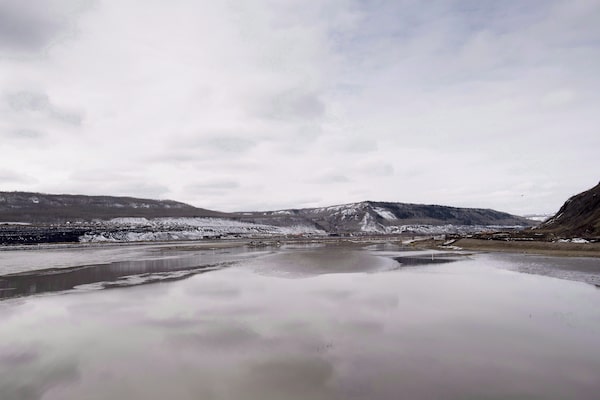
The Site C Dam location is seen along the Peace River in Fort St. John, B.C., April 18, 2017.JONATHAN HAYWARD/The Canadian Press
Despite skyrocketing construction costs and delays, the B.C. government has recommitted to the construction of the Site C dam. The half-built hydro-electric project on the Peace River now has a $16-billion price tag, new management, and a promise from Premier John Horgan to provide better oversight.
The revised project will be a year late, coming into service in 2025, at twice the original project cost. Questions remain about the estimated budget, and the potential for additional geo-technical problems.
“We are going to complete the project because it’s in the best interest of British Columbia,” Mr. Horgan told a news conference Friday. He was equivocal, however, about whether this will be the final budget revision. “I am confident that the numbers that we put forward today, as based on the assessment of treasury board and Hydro officials, are certain for today.”
Mr. Horgan and his New Democratic Party inherited the project from the former Liberal government in 2017, and reluctantly decided to continue with the dam. They increased the budget to $10.7-billion and pledged to provide strict oversight.
Since then, a series of challenges emerged, including delays owing to the pandemic. BC Hydro, the Crown corporation in charge of the project, revealed last August that geo-technical problems had emerged that it could not resolve within the existing budget.
Mr. Horgan commissioned an outside review, allowing him to deflect questions about the problems until after last fall’s election. On Friday, a summary of that review, by former deputy minister Peter Milburn, was released. Mr. Milburn recommended 17 changes to improve the management of the project.
The premier said he is implementing all the recommendations, and he has replaced the chair of Hydro’s board.
The Milburn report found that the oversight put in place by the NDP in 2017 did not head off problems. “As of September, 2020, BC Hydro has paid very large sums to the main civil works contractor for geotechnical issues. As the [project assurance board] were not actively engaged in this issue, they were not in a position to alert the provincial government to this potentially significant cost risk at an earlier date.”
Details of the new budget were not provided, and government officials could not say how much of the new costs are attributed to engineering changes.
The province also released a dam safety report that concludes the project can be safely completed, with new measures to address the technical challenges that have been identified to date.
BC Hydro was well into construction when it discovered that the clay and shale foundation it was building upon was not stabilized by bedrock below. It now proposes an engineering fix that involves anchoring the concrete structure with 125 steel-and-concrete piles, drilled deep to reach the bedrock.
However, the independent experts retained by government have warned that uncertainty remains “about the foundation conditions for the earthfill dam, as that area has yet to be excavated, mapped, and grouted,” documents released Friday show. Mr. Milburn agreed that “the risk of additional geotechnical issues on this project continues at the time of writing.”
In the end, Mr. Horgan said the decision was based on the same calculation as when he first approved the project in 2017: Too much money has been spent to stop the project. If the project were cancelled now, Hydro rate payers would face immediate increases. By finishing the project, rates won’t start to rise until 2025.
The BC Liberal opposition said the project was on time and on budget when the NDP took power. “Today’s report by Peter Milburn – finally released – shows how inept the NDP’s handling of the project has been,” Liberal energy critic Tom Shypitka said.
Environmentalists and Indigenous leaders expressed disappointment that the project is proceeding. Jessica Clogg, executive director of West Coast Environmental Law, said the “risky and unneeded project should have been cancelled long ago, but even now, it was not too late to change direction.”
The West Moberly First Nation is still heading to court seeking to halt the project. “We are not at all convinced that this project is safe,” Chief Roland Willson said.
We have a weekly Western Canada newsletter written by our B.C. and Alberta bureau chiefs, providing a comprehensive package of the news you need to know about the region and its place in the issues facing Canada. Sign up today.
 Justine Hunter
Justine Hunter